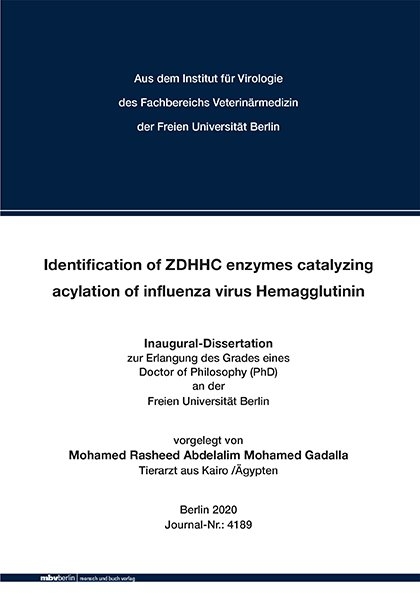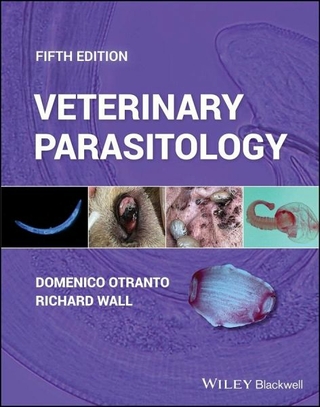
Identification of ZDHHC enzymes catalyzing acylation of influenza virus Hemagglutinin
Seiten
2020
|
1. Aufl.
Mensch & Buch (Verlag)
978-3-96729-040-0 (ISBN)
Mensch & Buch (Verlag)
978-3-96729-040-0 (ISBN)
- Keine Verlagsinformationen verfügbar
- Artikel merken
Influenza viruses are negative sense segmented enveloped RNA viruses covered with 2 surface peplomers: the trimeric hemagglutinin (HA), which catalyzes virus entry by binding to sialic acid containing receptors and by performing fusion of viral with endosomal membranes and the neuraminidase (NA), which is required for release of virus particles from infected cells. Among the influenza virus proteins, only HA and the proton-channel M2 are sitespecifically modified with fatty acids (S-acylated), which is essential for virus replication. Whereas two cysteines in the short cytoplasmic tail of HA contain only palmitate, stearate is exclusively attached to one cysteine located close to the cytoplasmic border of the transmembrane region (TMR). M2 is palmitoylated at a cysteine positioned in an amphiphilic helix near the TMR. The enzymes catalyzing acylation of HA and M2 have not been identified, but ZDHHC enzyme family who acylate cellular proteins are obvious candidates.
In the first part of this thesis, the expression of 23 ZDHHC family members was analyzed in human lung cells using qPCR. Results showed that all ZDHHCs (except ZDHHC19) are expressed. Interestingly, ZDHHC22 was upregulated during influenza virus infection suggesting that it might be involved in acylation of viral proteins. However, CRISPR/Cas9 mediated knockout of ZDHHC22 did not affect acylation of both intracellularly expressed HA and M2 as revealed by Acyl-RAC and click chemistry as well as HA incorporated into virus particles as shown by MALDI-TOF MS analysis. However, I confirmed that ZDHHC22 is an acyltransferase using LC/MS comparative palmitome analysis, which identified more than 50 proteins as substrates of ZDHHC22. Furthermore, I identified the nonstructural protein 1 (NS1) as the triggering factor for ZDHHC22 upregulation during influenza infection using expression vectors and virus deletion mutants.
In the second part, I identified for the first time 4 ZDHHC enzymes that are involved in acylation of hemagglutinin (HA). For screening, I used a siRNA library to knockdown expression of each of the 23 human ZDHHCs in HA-expressing Hela cells. siRNAs against ZDHHC2 and 8 had the strongest effect on acylation of HA as demonstrated by acyl-RAC and confirmed by 3H-palmitate labelling. The subsequent CRISPR/Cas9 knockout of ZDHHC2 and 8 in HAP1 cells, but also of the phylogenetically related ZDHHCs 15 and 20 strongly reduced acylation of group 1 and group 2 HAs and of M2, but individual ZDHHCs exhibit slightly different substrate preferences. These ZDHHCs co-localize with HA at membranes of the exocytic pathway in a human lung cell line. ZDHHC2, 8, 15 and 20 are not required for acylation of the hemagglutinin-esterase-fusion protein of Influenza C virus that contains only stearate at one transmembrane cysteine. Surprisingly, knockout of these ZDHHCs also did not compromise acylation of HA of Influenza B virus that contains two palmitoylated cysteines in its cytoplasmic tail. "Identifizierung von ZDHHC-Enzymen, die die Acylierung des Influenzavirus Hämagglutinin katalysieren"
Influenzaviren sind negativsträngige, segmentierte und umhüllte RNA-Viren, die mit zwei Oberflächen-Peplomeren bedeckt sind: dem trimeren Hämagglutinin (HA), das den Viruseintritt durch Bindung an Sialsäure-haltige Rezeptoren und durch Fusion von Viren mit endosomalen Membranen katalysiert und der Neuraminidase (NA) die für die Freisetzung von Viruspartikeln aus infizierten Zellen benötigt wird. Unter den Influenzavirus-Proteinen sind nur HA und der Protonenkanal M2 ortsspezifisch mit Fettsäuren (S-acyliert) modifiziert, was für die Virusreplikation essentiell ist. Während zwei Cysteine in der kurzen zytoplasmatischen Schwanz von HA nur Palmitat enthalten, ist Stearat ausschließlich an ein Cystein gebunden, das sich nahe der zytoplasmatischen Grenze der Transmembranregion (TMR) befindet. M2 wird an einem Cystein palmitoyliert, das sich in einer amphiphilen Helix in der Nähe des TMR befindet. Die Enzyme, die die Acylierung von HA und M2 katalysieren, wurden nicht identifiziert, aber Mitglieder der ZDHHC-Enzymfamilie, die zelluläre Proteine acylieren, sind offensichtliche Kandidaten.
Im ersten Teil dieser Arbeit wurde die Expression von 23 Mitgliedern der ZDHHC-Familie in menschlichen Lungenzellen mittels qPCR analysiert. Die Ergebnisse zeigten, dass alle ZDHHCs (außer ZDHHC19) exprimiert werden. Interessanterweise wurde ZDHHC22 während einer Influenzavirusinfektion hochreguliert, was darauf hindeutet, dass es an der Acylierung viraler Proteine beteiligt sein könnte. Das CRISPR / Cas9-vermittelte Knockout von ZDHHC22 wirkte sich jedoch nicht auf die Acylierung sowohl von intrazellulär exprimiertem HA als auch von M2 aus, wie durch Acyl-RAC- und Klick-Chemie sowie HA in Viruspartikeln nachgewiesen wurde, wie durch MALDI-TOF-MS-Analyse gezeigt. Ich bestätigte jedoch, dass ZDHHC22 eine Acyltransferase ist, indem ich eine LC / MSVergleichspalmitomanalyse durchführte, bei der mehr als 50 Proteine als Substrate von ZDHHC22 identifiziert wurden. Darüber hinaus identifizierte ich das nichtstrukturelle Protein 1 (NS1) als auslösenden Faktor für die ZDHHC22-Hochregulation während einer Influenza-Infektion unter Verwendung von Expressionsvektoren und Virus-Deletionsmutanten.
Im zweiten Teil habe ich erstmals 4 ZDHHC-Enzyme identifiziert, die an der Acylierung von Hämagglutinin (HA) beteiligt sind. Für das Screening verwendete ich eine siRNA-Bibliothek, um die Expression von jedem der 23 humanen ZDHHCs in HA-exprimierenden Hela-Zellen auszuschalten. siRNAs gegen ZDHHC2 und 8 hatten den stärksten Effekt auf die Acylierung von HA, wie es durch Acyl-RAC gezeigt und durch 3H-Palmitat-Markierung bestätigt wurde. Der anschließende CRISPR / Cas9-Knockout von ZDHHC2 und 8 in HAP1-Zellen, aber auch der phylogenetisch verwandten ZDHHCs 15 und 20 reduzierte die Acylierung von HAs der Gruppen 1 und 2 und von M2 stark. Einzelne ZDHHCs weisen jedoch geringfügig unterschiedliche Substratpräferenzen auf. Diese ZDHHCs lokalisieren in einer menschlichen Lungenzelllinie zusammen mit HA an Membranen des Exozytoseweges. ZDHHC2, 8, 15 und 20 werden für die Acylierung des Hämagglutinin-Esterase-Fusionsproteins des Influenza CVirus, das nur Stearat an einer Transmembran-Cystein enthält, nicht benötigt. Überraschenderweise beeinträchtigte das Knockout dieser ZDHHCs auch nicht die Acylierung von HA des Influenza B-Virus, das zwei palmitoylierte Cysteine in seinem cytoplasmatischen Schwanz enthält.
In the first part of this thesis, the expression of 23 ZDHHC family members was analyzed in human lung cells using qPCR. Results showed that all ZDHHCs (except ZDHHC19) are expressed. Interestingly, ZDHHC22 was upregulated during influenza virus infection suggesting that it might be involved in acylation of viral proteins. However, CRISPR/Cas9 mediated knockout of ZDHHC22 did not affect acylation of both intracellularly expressed HA and M2 as revealed by Acyl-RAC and click chemistry as well as HA incorporated into virus particles as shown by MALDI-TOF MS analysis. However, I confirmed that ZDHHC22 is an acyltransferase using LC/MS comparative palmitome analysis, which identified more than 50 proteins as substrates of ZDHHC22. Furthermore, I identified the nonstructural protein 1 (NS1) as the triggering factor for ZDHHC22 upregulation during influenza infection using expression vectors and virus deletion mutants.
In the second part, I identified for the first time 4 ZDHHC enzymes that are involved in acylation of hemagglutinin (HA). For screening, I used a siRNA library to knockdown expression of each of the 23 human ZDHHCs in HA-expressing Hela cells. siRNAs against ZDHHC2 and 8 had the strongest effect on acylation of HA as demonstrated by acyl-RAC and confirmed by 3H-palmitate labelling. The subsequent CRISPR/Cas9 knockout of ZDHHC2 and 8 in HAP1 cells, but also of the phylogenetically related ZDHHCs 15 and 20 strongly reduced acylation of group 1 and group 2 HAs and of M2, but individual ZDHHCs exhibit slightly different substrate preferences. These ZDHHCs co-localize with HA at membranes of the exocytic pathway in a human lung cell line. ZDHHC2, 8, 15 and 20 are not required for acylation of the hemagglutinin-esterase-fusion protein of Influenza C virus that contains only stearate at one transmembrane cysteine. Surprisingly, knockout of these ZDHHCs also did not compromise acylation of HA of Influenza B virus that contains two palmitoylated cysteines in its cytoplasmic tail. "Identifizierung von ZDHHC-Enzymen, die die Acylierung des Influenzavirus Hämagglutinin katalysieren"
Influenzaviren sind negativsträngige, segmentierte und umhüllte RNA-Viren, die mit zwei Oberflächen-Peplomeren bedeckt sind: dem trimeren Hämagglutinin (HA), das den Viruseintritt durch Bindung an Sialsäure-haltige Rezeptoren und durch Fusion von Viren mit endosomalen Membranen katalysiert und der Neuraminidase (NA) die für die Freisetzung von Viruspartikeln aus infizierten Zellen benötigt wird. Unter den Influenzavirus-Proteinen sind nur HA und der Protonenkanal M2 ortsspezifisch mit Fettsäuren (S-acyliert) modifiziert, was für die Virusreplikation essentiell ist. Während zwei Cysteine in der kurzen zytoplasmatischen Schwanz von HA nur Palmitat enthalten, ist Stearat ausschließlich an ein Cystein gebunden, das sich nahe der zytoplasmatischen Grenze der Transmembranregion (TMR) befindet. M2 wird an einem Cystein palmitoyliert, das sich in einer amphiphilen Helix in der Nähe des TMR befindet. Die Enzyme, die die Acylierung von HA und M2 katalysieren, wurden nicht identifiziert, aber Mitglieder der ZDHHC-Enzymfamilie, die zelluläre Proteine acylieren, sind offensichtliche Kandidaten.
Im ersten Teil dieser Arbeit wurde die Expression von 23 Mitgliedern der ZDHHC-Familie in menschlichen Lungenzellen mittels qPCR analysiert. Die Ergebnisse zeigten, dass alle ZDHHCs (außer ZDHHC19) exprimiert werden. Interessanterweise wurde ZDHHC22 während einer Influenzavirusinfektion hochreguliert, was darauf hindeutet, dass es an der Acylierung viraler Proteine beteiligt sein könnte. Das CRISPR / Cas9-vermittelte Knockout von ZDHHC22 wirkte sich jedoch nicht auf die Acylierung sowohl von intrazellulär exprimiertem HA als auch von M2 aus, wie durch Acyl-RAC- und Klick-Chemie sowie HA in Viruspartikeln nachgewiesen wurde, wie durch MALDI-TOF-MS-Analyse gezeigt. Ich bestätigte jedoch, dass ZDHHC22 eine Acyltransferase ist, indem ich eine LC / MSVergleichspalmitomanalyse durchführte, bei der mehr als 50 Proteine als Substrate von ZDHHC22 identifiziert wurden. Darüber hinaus identifizierte ich das nichtstrukturelle Protein 1 (NS1) als auslösenden Faktor für die ZDHHC22-Hochregulation während einer Influenza-Infektion unter Verwendung von Expressionsvektoren und Virus-Deletionsmutanten.
Im zweiten Teil habe ich erstmals 4 ZDHHC-Enzyme identifiziert, die an der Acylierung von Hämagglutinin (HA) beteiligt sind. Für das Screening verwendete ich eine siRNA-Bibliothek, um die Expression von jedem der 23 humanen ZDHHCs in HA-exprimierenden Hela-Zellen auszuschalten. siRNAs gegen ZDHHC2 und 8 hatten den stärksten Effekt auf die Acylierung von HA, wie es durch Acyl-RAC gezeigt und durch 3H-Palmitat-Markierung bestätigt wurde. Der anschließende CRISPR / Cas9-Knockout von ZDHHC2 und 8 in HAP1-Zellen, aber auch der phylogenetisch verwandten ZDHHCs 15 und 20 reduzierte die Acylierung von HAs der Gruppen 1 und 2 und von M2 stark. Einzelne ZDHHCs weisen jedoch geringfügig unterschiedliche Substratpräferenzen auf. Diese ZDHHCs lokalisieren in einer menschlichen Lungenzelllinie zusammen mit HA an Membranen des Exozytoseweges. ZDHHC2, 8, 15 und 20 werden für die Acylierung des Hämagglutinin-Esterase-Fusionsproteins des Influenza CVirus, das nur Stearat an einer Transmembran-Cystein enthält, nicht benötigt. Überraschenderweise beeinträchtigte das Knockout dieser ZDHHCs auch nicht die Acylierung von HA des Influenza B-Virus, das zwei palmitoylierte Cysteine in seinem cytoplasmatischen Schwanz enthält.
| Erscheinungsdatum | 29.06.2020 |
|---|---|
| Verlagsort | Berlin |
| Sprache | englisch |
| Maße | 148 x 210 mm |
| Themenwelt | Veterinärmedizin ► Allgemein |
| Veterinärmedizin ► Klinische Fächer ► Parasitologie | |
| Schlagworte | Cell Culture • cell lines • CRISPR-Cas9 • fatty acids • hemagglutinins • Influenzaviren • influenza viruses • MALDI-TOF • MAN • Matrix protein • Palmitate • Polymerase chain reaction • Respiratory System • SDS-PAGE • stearic acid • transmembrane proteins • Western blotting |
| ISBN-10 | 3-96729-040-9 / 3967290409 |
| ISBN-13 | 978-3-96729-040-0 / 9783967290400 |
| Zustand | Neuware |
| Informationen gemäß Produktsicherheitsverordnung (GPSR) | |
| Haben Sie eine Frage zum Produkt? |
Mehr entdecken
aus dem Bereich
aus dem Bereich
Buch | Spiralbindung (2023)
Schlütersche (Verlag)
179,00 €


